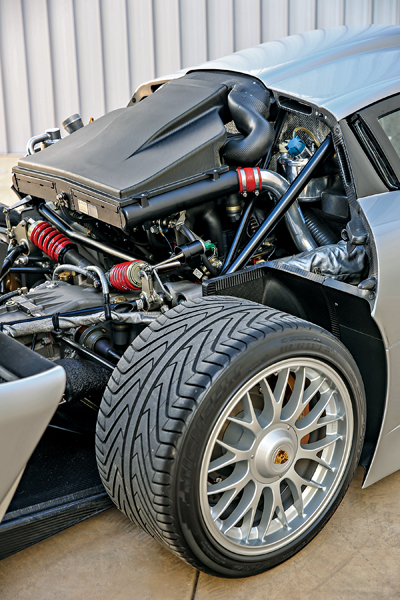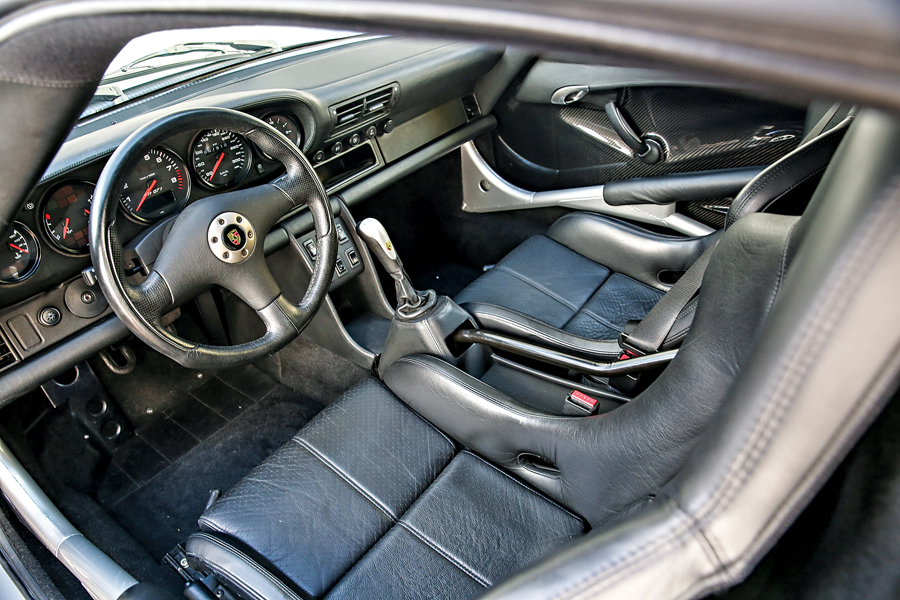- The ultimate Porsche supercar; one of only 20 examples built
- Street version of the legendary Le Mans-winning 911 GT1
- Highly original example in iconic Arctic Silver-over-black color scheme
- Recent service at DeMan Motorsport; approximately 7,900 km (4,908 miles) from new
- Offered with rare factory owner’s and workshop manuals, sales brochure, tools and accessories
- 3,164-cc DOHC Type M96/83 flat 6-cylinder engine
- Bosch Motronic M5.2 fuel injection
- Twin KKK turbochargers
- 544 horsepower at 7,000 rpm
SCM Analysis
Detailing
| Vehicle: | 1998 Porsche 911/996 GT1 Strassenversion |
| Years Produced: | 1996–98 |
| Number Produced: | Street cars, 20 with 996-front and two with 993-front with M96/83 engines; six factory and nine customer race cars with M96/80 engines |
| Original List Price: | Approximately $900,000 |
| SCM Valuation: | $5.7 million (this car) |
| Tune Up Cost: | $5,000 |
| Chassis Number Location: | Silver metal plate on inside rear frame of passenger’s door |
| Engine Number Location: | Stamped into flange on engine case where bolted to the gearbox, passenger’s side, facing upward |
| Club Info: | Porsche Club of America |
| Website: | http://www.pca.org |
| Alternatives: | 1992–98 McLaren F1, 1998–99 Mercedes CLK/GTR, 1995–97 Ferrari F50 |
| Investment Grade: | A |
This car, Lot 42, sold for $5,665,000, including buyer’s premium, at Gooding & Company’s auction on Amelia Island, FL, on March 10, 2017.
This sale was highly anticipated from the moment its consignor acquired a second GT1. For several years, interest in GT1s has been building worldwide. The prospect of this car coming to auction enriched that activity. I visited and assessed the Gooding-offered GT1 in October 2016. It was a very nice example.
Early consignment and ace marketing
In an example of “doing it right,” the consignor committed four highly collectible Porsches to Gooding last winter — well in advance of the Amelia Island auction. Gooding did their part — taking the four cars to Scottsdale for a venue-dominating display, complete with an oversized four-color multipage handout. Advertising and an email campaign featuring the GT1 followed. Gooding reported that pre-sale interest in the GT1 was very strong.
All the fuss was justified
The Porsche 911 GT1 is a world-best automobile. It is the top of the pyramid of Porsche street cars, and it is the homologation base for a winning race car.
First, it is very rare, with just 20 examples built of this 996-front-bodied version, plus two (probably not three, as widely reported) earlier 993-front-bodied versions.
Second, the specifications are stellar, with 544 horsepower from the midships flat 6-cylinder, twin-turbocharged, water-cooled 3,164-cc engine. With a carbon-fiber body and tub, the car weighs just 2,094 pounds. The suspension is the latest Porsche technology of that era, which is to say superb.
Third, the car has excellent performance numbers: 0–62 mph (100 kph) in 3.7 seconds and a top speed of 192 mph (310 km/h) — all this in the mid-1990s.
Finally, the car’s provenance is noteworthy. The GT1’s race-car brother, the GT1/98, placed 1st and 2nd overall at Le Mans in 1998.
Forcing Porsche to reach deep
The post-962 era for Porsche racing was a somewhat tumultuous time.
Sanctioning bodies and rules were in flux in both prototype and GT racing.
Porsche’s response was to move away from prototypes back toward production-based racing models. Into the GT-sanctioning breach came a group that included Porsche’s own Jürgen Barth, the “B” in the BPR Global GT Series, together with Patrick Peter and Stephane Ratel.
The initial rules package was considered loose, and McLaren was the first to take advantage of the situation. Their BMW-powered F1 GTR was unbeatable, and it won the 1995 running of Le Mans. That sent Porsche’s famed Norbert Singer and his experienced engineering squad to the drawing boards.
From that effort emerged the first-generation Porsche GT1, a car that placed 2nd and 3rd at Le Mans in 1996 — and won the GT1 class, just one lap down to the winning prototype TWR/Porsche. (That car was the old Tom Walkinshaw Jaguar XJR-14 tub updated with a Porsche 962-like engine, all managed by Joest Racing.) The GT1 went on to win the last three BPR Global GT races of the season.
1997–98 was gloomy, but 1998 had a sunny spot
The FIA returned to sanctioning GT racing for 1997. Peter and Ratel parted ways with BPR, creating separate smaller national series. Unfortunately, the FIA looked at the Porsche GT1’s performance at Le Mans and those last three BBR races in 1996 and put induction restrictors on the car. FIA also had firmer homologation rules than BPR. No longer would a manufacturer’s promise to build 20 road cars “sooner or later” suffice.
Mercedes/AMG and McLaren/BMW dominated GT racing in 1997, although that same Joest-owned TRW-Porsche again won Le Mans as a prototype. At the Sarthe, the updated 1997 Porsche GT1 Evolution finished 3rd and 4th in GT1 (5th and 8th overall) behind McLaren F1s in 1st and 2nd (3rd and 4th overall).
For 1998, Singer and his staff redesigned the GT1. They changed from steel to carbon fiber for the monocoque tub (the body panels were always carbon fiber), reworked the dimensions so they could move the gas tank from the front trunk to the rear bulkhead just ahead of the engine, and they tweaked the suspension and the aerodynamics. This time they manufactured the requisite 20 homologation street cars. Those Strassenversion GT1s were barely detuned or softened vs. the racing GT1/98, although a real interior was added, with two leather seats instead of one in Nomex for the race car.
Although the Mercedes CLK/GTRs won literally every race in the 1998 FIA GT1 Series, Porsche’s 1st and 2nd overall finishes at Le Mans made the Porsche GT1 a desirable classic.
Only Le Mans and the 24 Hours of Daytona can affect a car’s reputation that vigorously. The 12 Hours of Sebring and Spa’s FIA race also have positive but smaller influences.
A charmed life
Our subject car has lived a charmed, fully documented life. It is serial number 005, optioned with air conditioning (!) and extra seat padding — so it is almost a Komfort version. Porsche’s Munich dealer sold the car, for the equivalent of about $900,000, to Tobias Kemper, who street-drove it 4,440 km (2,758 miles) of its total 7,900 km (4,908 miles).
The car came to the United States in 2003 to Florida’s Don Wallace, who was ahead of his time in collecting rare, race-bred GT cars. It was an early Show or Display entry into the United States, which exempted it from DoT regulations.
Fortunately, a master ME/EE engineer — Jonathan Weisheit at JK Technologies in Baltimore — performed the EPA Federalization. Anything less would have hurt the car’s value. GT1 005 passed back to Germany to Manfred Freisinger in 2012 — and then went on to its consignor in Michigan.
A frenzy of activity preceded this GT1’s auction
When this GT1 was consigned to Gooding, there were at least three GT1s for sale around the world.
Potential buyers hovered over them, trying to divine where prices would settle, which car was better — or best — and which car was the strongest value.
At least two of those cars sold as buyers chose to hedge against a strong result at the Gooding auction. As most expected, the auction result was indeed strong, a world-record result — for a public or private sale.
A knowledgeable and wealthy Brazilian industrialist living in the U.K. won the bidding battle. With all the attention, light and heat put on this GT1, the market spoke eloquently. The sale price — $5,665,000 — is the current norm for a fine GT1.
Is the new supercar dream collection a Porsche GT1, a McLaren F1, and a Mercedes CLK/GTR? By the way, Don Wallace had those three cars — 15 years ago. ♦
(Introductory description courtesy of Gooding & Company.)





